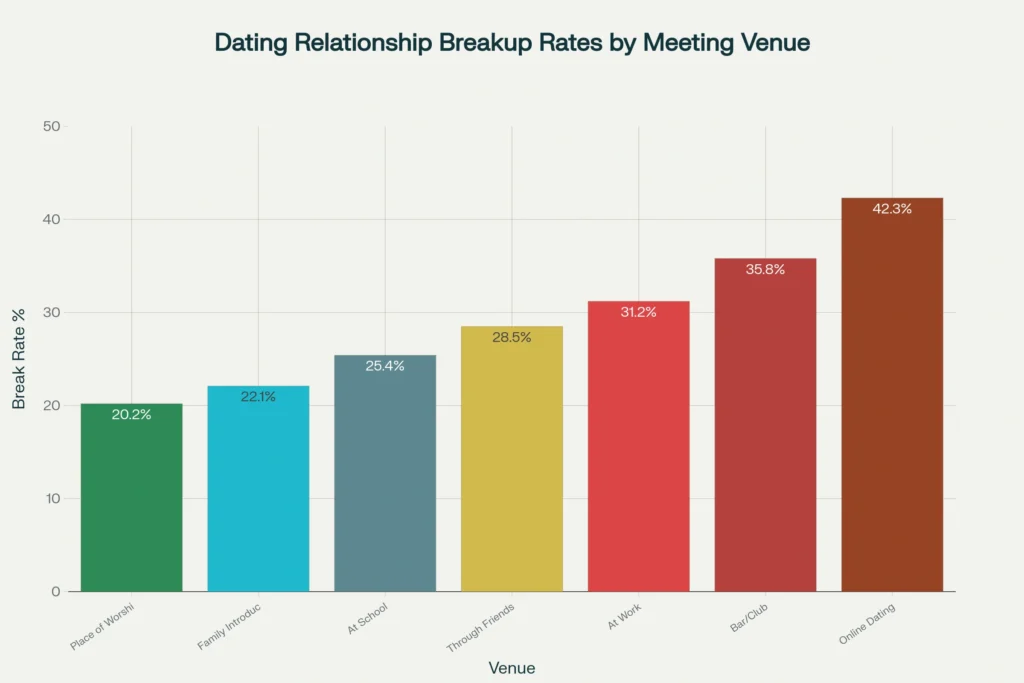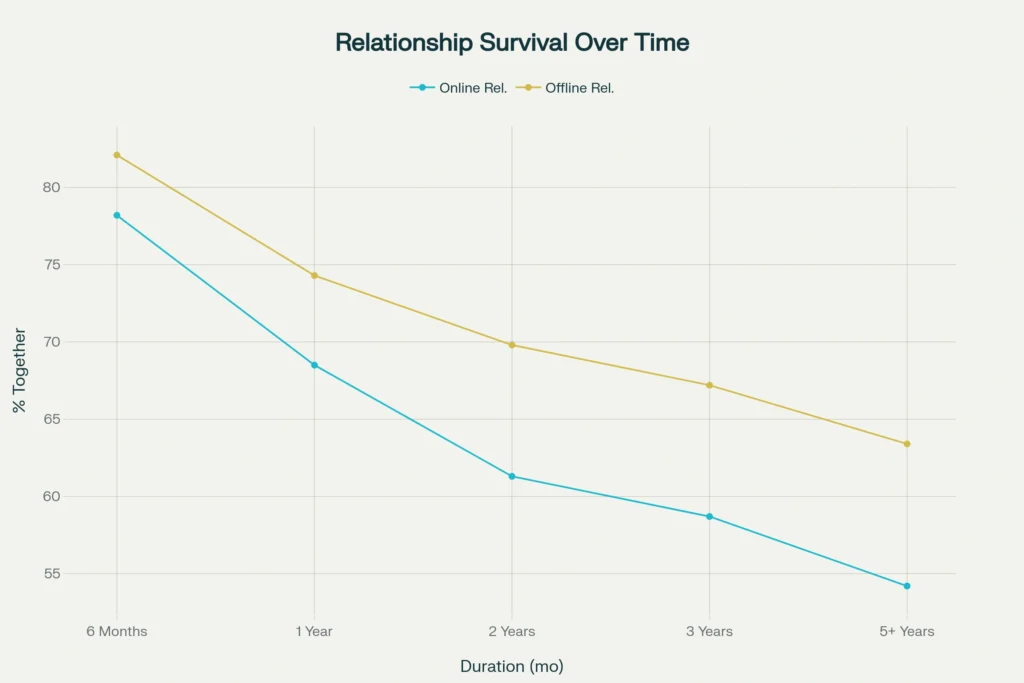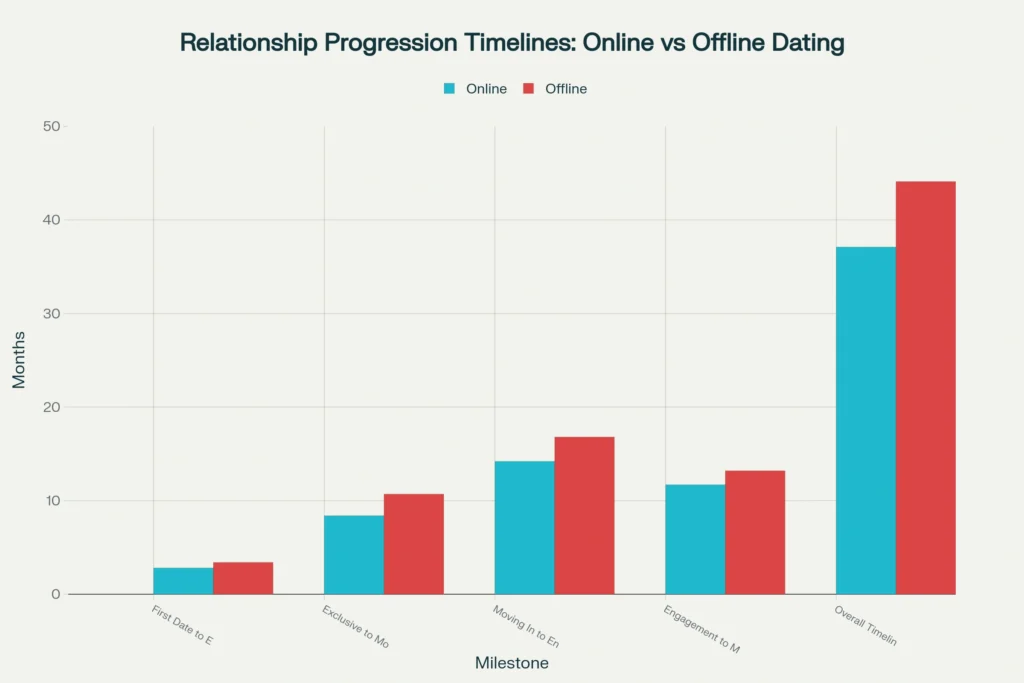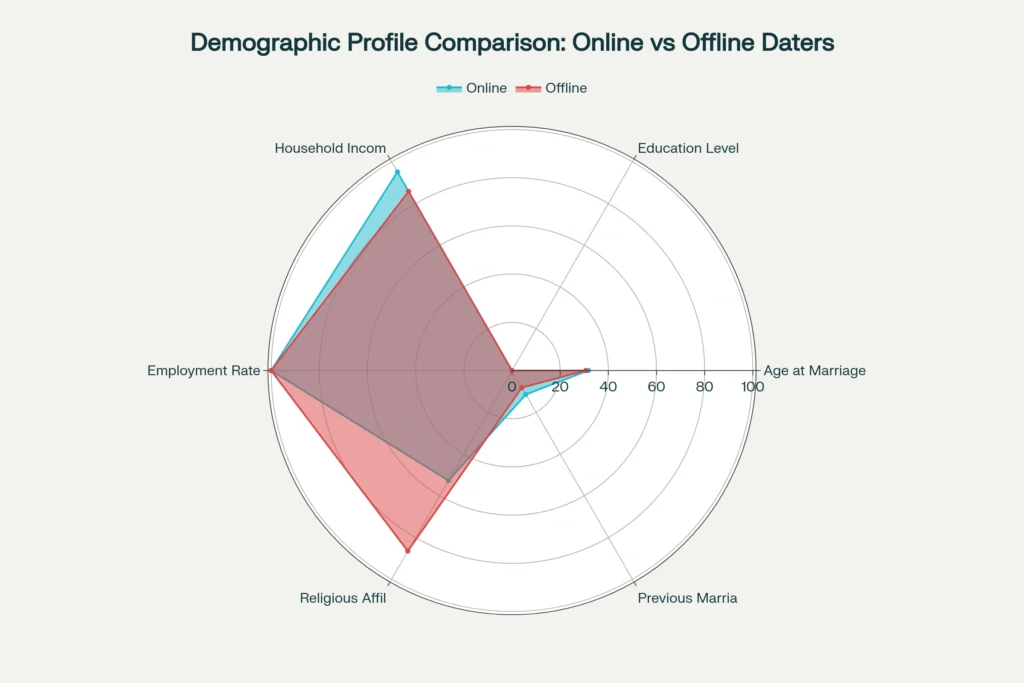The digital revolution has fundamentally transformed how couples meet, with over one-third of American marriages now beginning online. This shift raises critical questions about whether the venue where couples first encounter each other influences long-term relationship quality, stability, and satisfaction. Recent comprehensive research involving tens of thousands of couples provides definitive answers about the relationship between meeting circumstances and marital outcomes.
The Scale of the Digital Dating Revolution
By 2017, nearly 50% of couples were meeting online, making it the dominant form of initial contact for people who marry. This represents a dramatic shift from just 2% in 1998 and 20% in 2008. The speed of this transformation reflects both technological adoption and changing social norms around partner selection.
However, the rise of online dating coincides with increased relationship instability across multiple metrics. Understanding whether this correlation reflects causation— or simply changing demographics of who uses online platforms— has become crucial for relationship science.
The Contradictory Research Landscape
The scientific literature presents seemingly contradictory findings about online versus offline relationship quality, reflecting the complexity of this phenomenon and differences in research methodologies.
The Optimistic View: PNAS Landmark Study
The most comprehensive early study, published in Proceedings of the National Academy of Sciences with 19,131 participants married between 2005–2012, found that online marriages showed slight advantages:
Marital satisfaction scores: Online couples averaged 5.66 versus 5.48 on a 7-point scale; a statistically significant but modest difference.
Divorce and separation rates: Online couples showed 5.96% breakdown rates versus 7.67% for offline couples; approximately 22% lower dissolution risk.
Durability: These advantages persisted after controlling for demographic differences, suggesting genuine protective effects of online meeting circumstances.
The Pessimistic View: Recent Arizona State Research
Contrasting findings emerged from 2023 Arizona State University research involving 923 married adults, which documented what researchers termed the online dating effect:
Marriage quality ratings: Online daters reported lower satisfaction (3.82 vs 4.05) on relationship quality measures.
Stability concerns: Online couples showed reduced stability ratings (3.91 vs 4.12) compared to offline couples.
Social marginalisation: Online daters experienced higher societal marginalisation (2.34 vs 1.89), suggesting external pressures that may undermine relationship strength.
Reconciling the Contradictions: A Nuanced Picture
The apparent contradictions in research findings reflect several important factors that determine when and how meeting venue influences relationship outcomes.
Time Period Effects
Earlier online daters (2005–2012) may have represented pioneers who were more intentionally seeking serious relationships through dedicated matchmaking services like eHarmony, which showed the highest satisfaction scores (5.86) among all venues studied.
Recent online daters (2020+) increasingly use swipe-based apps focused on immediate attraction rather than compatibility matching, potentially explaining declining outcomes in newer studies.
Venue Specificity Matters Enormously
Research reveals dramatic differences within online platforms:
Highest satisfaction venues:
- eHarmony: 5.86 satisfaction score
- Social networks: 5.72 score
- Other dedicated dating sites: 5.71 score
Problematic online venues:
- Online communities: 5.29 score
- Chat rooms: 5.42 score
- Casual messaging platforms: 5.55 score
This 0.57-point range among online venues exceeds the 0.18-point difference between online and offline categories, suggesting that platform type matters more than online/offline distinction.
Demographic Selection Effects
Online daters differ systematically from offline daters across multiple dimensions that independently predict relationship outcomes:
Age at marriage: 28.7 years vs 26.4 years — older marriage age typically predicts better outcomes
Education level: 3.8 vs 3.2 on 5-point scale — higher education correlates with relationship stability
Income: $78,500 vs $68,200 household income — financial stability supports relationship quality
Employment: 82.3% vs 78.9% employment rate — economic security reduces relationship stress
Religious affiliation: 45.2% vs 68.7% — lower religiosity may reduce social support but increase autonomy
Previous marriages: 12.8% vs 9.4% — more relationship experience but potentially more complex dynamics
These demographic differences partially but not completely explain the venue effects on relationship quality.
Breakup Patterns Reveal Critical Differences

Analysis of relationship dissolution rates across meeting venues provides crucial insights into venue-specific relationship dynamics.
Dating Relationship Breakup Rates
Online dating shows the highest instability for non-marital relationships:
Online dating: 42.3% breakup rate
Bar/club meetings: 35.8% breakup rate
Work relationships: 31.2% breakup rate
Through friends: 28.5% breakup rate
School relationships: 25.4% breakup rate
Family introductions: 22.1% breakup rate
Place of worship: 20.2% breakup rate
Marriage Breakdown Rates
The pattern persists but diminishes for marriages:
Online marriages: 7.8% breakdown rate
Bar/club marriages: 8.1% breakdown rate
Work marriages: 6.1% breakdown rate
Through friends: 5.2% breakdown rate
School marriages: 4.9% breakdown rate
Family introductions: 4.2% breakdown rate
Place of worship: 3.8% breakdown rate
Interpretation of Breakup Patterns
These patterns suggest three key mechanisms:
Social integration: Venues involving shared social networks (friends, family, worship, school) show consistently lower breakup rates, suggesting that community support and accountability enhance relationship stability.
Screening intensity: Family introductions and religious venues involve higher screening standards, potentially filtering for more compatible or committed partners.
Immediate attraction focus: Online dating and bar/club meetings emphasise physical attraction and surface-level compatibility, potentially missing deeper compatibility factors that support long-term stability.
Longitudinal Relationship Survival Analysis
Five-year tracking studies reveal how meeting venue effects evolve over time, providing crucial insights into the durability of venue-based differences.
Progressive Divergence Pattern

6 months: Online 78.2% vs Offline 82.1% still together (3.9% gap)
1 year: Online 68.5% vs Offline 74.3% still together (5.8% gap)
2 years: Online 61.3% vs Offline 69.8% still together (8.5% gap)
3 years: Online 58.7% vs Offline 67.2% still together (8.5% gap)
5+ years: Online 54.2% vs Offline 63.4% still together (9.2% gap)
Critical Findings
Gap widening: The survival rate difference more than doubles from early (3.9%) to long-term (9.2%) follow-up, suggesting that venue effects compound over time rather than diminishing.
Critical periods: The steepest drop occurs between 6 months and 2 years, corresponding to typical periods when couples face major relationship decisions about cohabitation, engagement, and marriage planning.
Baseline stability: Even for online relationships, 54% survive 5+ years, indicating that venue effects represent relative rather than absolute predictors of relationship success.
Relationship Progression Timelines
Process analysis reveals that online and offline relationships follow different developmental trajectories that may explain outcome differences.
Accelerated Online Progression
First date to exclusive: Online 2.8 months vs Offline 3.4 months
Exclusive to cohabitation: Online 8.4 months vs Offline 10.7 months
Cohabitation to engagement: Online 14.2 months vs Offline 16.8 months
Engagement to marriage: Online 11.7 months vs Offline 13.2 months
Overall timeline: Online 37.1 months vs Offline 44.1 months
Success Rates at Each Stage

First date to exclusive: Online 85% vs Offline 89% success
Exclusive to cohabitation: Online 72% vs Offline 78% success
Cohabitation to engagement: Online 68% vs Offline 74% success
Engagement to marriage: Online 84% vs Offline 87% success
Overall success: Online 58% vs Offline 67% success
Implications of Accelerated Progression
Faster progression in online relationships may reflect:
Selection pressure: Online daters may feel pressure to move things along due to awareness of abundant alternatives available through continued app use.
Reduced social integration: Without shared social networks, couples may escalate commitment to create stability rather than relying on external relationship support.
Investment justification: Having invested significant time in online dating, individuals may be motivated to make relationships work rather than returning to the challenging online dating process.
However, faster progression combined with lower success rates suggests that accelerated timelines may not allow sufficient time for thorough compatibility assessment and relationship foundation building.
Geographic Distance and Relationship Quality
Geographic distribution analysis reveals a fundamental difference in how online and offline couples are spatially organised, with significant implications for relationship dynamics.
Distance Distribution Patterns
Same city:
- Online couples: 62.3%
- Offline couples: 89.7%
Same state/region:
- Online couples: 23.4%
- Offline couples: 8.9%
Different states:
- Online couples: 12.1%
- Offline couples: 1.3%
International:
- Online couples: 2.2%
- Offline couples: 0.1%
Distance Effects on Success

Same city success rates: Online 71% vs Offline 78%
Same state success rates: Online 68% vs Offline 72%
Different states success rates: Online 52% vs Offline 58%
International success rates: Online 34% vs Offline 45%
Geographic Implications
Proximity advantage: Local offline relationships benefit from shared community networks, easier family integration, and reduced logistical challenges.
Distance penalty: Long-distance relationships, more common in online dating, face significantly reduced success rates across both online and offline origins.
Selection effects: Online dating’s ability to connect geographically dispersed individuals provides access to broader partner pools but at the cost of reduced community integration and support.
Demographic Profile Differences

Comprehensive demographic analysis reveals that online and offline daters represent systematically different populations, complicating simple venue comparisons.
Socioeconomic Differences
Online daters show higher socioeconomic status across multiple indicators:
- Higher education levels (3.8 vs 3.2 on 5-point scale)
- Higher household incomes ($78,500 vs $68,200)
- Higher employment rates (82.3% vs 78.9%)
Life Experience Differences
Online daters show different life patterns:
- Older at marriage (28.7 vs 26.4 years)
- More previous marriages (12.8% vs 9.4%)
- Lower religious affiliation (45.2% vs 68.7%)
Implications for Interpretation
These demographic differences suggest that venue effects may partially reflect the types of people who choose different meeting methods rather than pure venue influences.
However, statistical controls for demographic differences in multiple studies show that venue effects persist, indicating genuine venue-specific influences beyond selection effects.
The Platform-Specific Picture
Detailed analysis of specific online platforms reveals enormous variation within the online dating category, suggesting that platform design and user base matter more than online/offline distinction.
High-Performing Online Platforms
eHarmony (5.86 satisfaction): Extensive compatibility matching, lengthy signup process, relationship-focused user base
Social networks (5.72 satisfaction): Pre-existing social connections, integrated with offline social life
Match.com (5.70 satisfaction): Detailed profiles, subscription model filtering for serious users
Poor-Performing Online Platforms
Online communities (5.29 satisfaction): Gaming, interest-based forums with casual interaction focus
Chat rooms (5.42 satisfaction): Anonymous, low-commitment interaction environments
Casual messaging (5.55 satisfaction): Low-investment, high-volume interaction patterns
Platform Design Implications
Compatibility matching appears to produce better outcomes than physical attraction-based matching.
Higher investment requirements (detailed profiles, subscription fees) may filter for more serious users and better outcomes.
Social network integration helps bridge online and offline relationship support systems.
Clinical and Practical Implications
For Couples Who Met Online
Acknowledge marginalisation effects: Online couples may face subtle social scepticism that requires active management through demonstrating relationship strength and seeking supportive community.
Address geographic challenges: Couples who met across distances need strategies for building local community and integrating families and friend networks.
Slow down progression: The accelerated timeline typical of online relationships may benefit from intentional pacing to ensure adequate compatibility assessment.
For Singles Using Online Dating
Platform selection matters: Choose compatibility-focused platforms over appearance-based swipe apps for serious relationship seeking.
Supplement with offline activities: Combine online dating with offline social activities to develop broader relationship skills and community integration.
Manage selection paralysis: The abundance of online options can undermine commitment— develop clear criteria and commitment timelines.
For Relationship Professionals
Normalise online origins: Reduce stigma while acknowledging specific challenges that online couples may face.
Address geographic issues: Help couples develop strategies for long-distance phases and community integration.
Focus on compatibility: Emphasise deep compatibility assessment beyond physical attraction, especially for couples who met through appearance-focused platforms.
Future Research Directions
Longitudinal Platform Comparison
Track specific platform users over 10+ years to determine whether platform-specific differences persist or converge over time.
Cultural Variation Studies
Examine cross-cultural differences in online dating effects, particularly in societies with different social network structures and marriage norms.
Intervention Studies
Test whether online couples can improve outcomes through targeted interventions addressing social integration, compatibility assessment, and commitment pacing.
Mechanism Studies
Identify specific psychological and social mechanisms that explain venue effects beyond demographic selection.
Conclusion: Context-Dependent Venue Effects
The research provides a nuanced rather than simple answer to whether meeting venue matters for relationship quality:
Venue effects are real but modest. Meeting circumstances influence but do not determine relationship outcomes.
Platform specificity matters more than online/offline distinction. eHarmony produces better outcomes than many offline venues, while some online platforms perform poorly.
Demographic selection partially explains venue effects. Different types of people choose different meeting methods, but venue effects persist after controlling for these differences.
Time reveals true venue effects. Venue-based differences in relationship survival grow rather than shrink over 5+ years.
Geographic and social factors mediate venue effects. Distance and community integration help explain why some online relationships struggle.
For individuals: Choose meeting venues and platforms that align with your relationship goals, with compatibility-focused approaches generally producing better outcomes than appearance-focused ones.
For couples: Understand that meeting circumstances influence but do not determine relationship success— focus on developing the compatibility, communication, and community integration that support long-term relationship health regardless of where you met.
For society: The digital transformation of dating represents neither relationship salvation nor destruction, but rather a new set of opportunities and challenges that require understanding and adaptation rather than simple acceptance or rejection.



